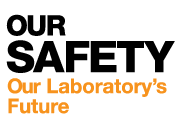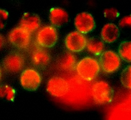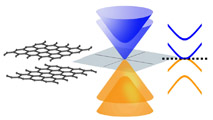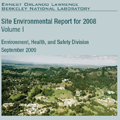



By Ken Wan, Life Sciences
In our research, we use a variety of molecular biological techniques, with a heavy emphasis on high-throughput DNA and RNA protocols. Most of our methods do not involve hazardous materials, but we still need Personal Protective Equipment (PPE) to protect ourselves, and clean work surfaces and apparatuses to ensure sample purity and the removal of enzymes that degrade RNA. RNase enzymes are found on our skin, so we wear gloves as a protective barrier. Cross-contamination is also a big concern since we process large numbers of samples. Polymerase chain reaction is a particular concern as this technique amplifies DNA from minute amounts of starting material.
As a genomics lab focused on large-scale projects, we require high efficiency and reproducibility. To optimize our work, we constantly think about the details of what we do. This "continuous improvement" mindset goes hand-in-hand with the Integrated Safety Management (ISM) approach to ensure lab safety. In fact, we have found that thinking about ISM actually improves the efficiency of our data production pipelines. For example, high throughput protocols involve a lot of manual pipetting, which presents an ergonomic hazard. By transferring some pipetting steps to robots, we reduce the risk of injury and allow the researcher to multi-task. The best practices employed to ensure the success of an experiment often also lead to a safer work environment.
Share your safety story.
 Berkeley Lab and China’s Peking University agreed last Thursday to jointly pursue the development of safe and effective carbon capture and storage techniques. This technology holds strong promise to help mitigate climate change by capturing carbon dioxide from major sources, such as coal-burning power plants, and injecting it deep underground for permanent storage. Berkeley Lab and China's Peking University will jointly tackle carbon capture and storage research, thanks to a memorandum of understanding signed by Shiyi Chen (left), dean of the College of Engineering at Peking University, and Don DePaolo, director of Berkeley Lab’s Earth Sciences Division. More>
Berkeley Lab and China’s Peking University agreed last Thursday to jointly pursue the development of safe and effective carbon capture and storage techniques. This technology holds strong promise to help mitigate climate change by capturing carbon dioxide from major sources, such as coal-burning power plants, and injecting it deep underground for permanent storage. Berkeley Lab and China's Peking University will jointly tackle carbon capture and storage research, thanks to a memorandum of understanding signed by Shiyi Chen (left), dean of the College of Engineering at Peking University, and Don DePaolo, director of Berkeley Lab’s Earth Sciences Division. More>
 Meiosis — the pairing and recombination of chromosomes, followed by segregation of half to each egg or sperm cell — is a major crossroads in all organisms reproducing sexually. Yet how the cell precisely choreographs these chromosomal interactions is a long-standing question. New findings by UC Berkeley and Berkeley Lab scientist Abby Dernburg show that the cell's cytoskeleton, which moves things around in the cell, plays a critical role, essentially reaching into the nucleus to bring chromosome pairs together in preparation for recombination and segregation. More>
Meiosis — the pairing and recombination of chromosomes, followed by segregation of half to each egg or sperm cell — is a major crossroads in all organisms reproducing sexually. Yet how the cell precisely choreographs these chromosomal interactions is a long-standing question. New findings by UC Berkeley and Berkeley Lab scientist Abby Dernburg show that the cell's cytoskeleton, which moves things around in the cell, plays a critical role, essentially reaching into the nucleus to bring chromosome pairs together in preparation for recombination and segregation. More>
 IBM and Berkeley Lab announced yesterday that an IBM System X iDataPlex server will run the Lab's program to explore how cloud computing can be used to advance scientific discovery. The program, dubbed Magellan, is funded by the American Recovery and Reinvestment Act through the Department of Energy. The Magellan system will be a testbed for National Energy Research Scientific Computing Division scientists to explore the effectiveness of cloud computing for their particular research problems. Ultimately, the project will benefit society by allowing scientists to accelerate discoveries in such disciplines as energy efficiency, climate change and genomics. More>
IBM and Berkeley Lab announced yesterday that an IBM System X iDataPlex server will run the Lab's program to explore how cloud computing can be used to advance scientific discovery. The program, dubbed Magellan, is funded by the American Recovery and Reinvestment Act through the Department of Energy. The Magellan system will be a testbed for National Energy Research Scientific Computing Division scientists to explore the effectiveness of cloud computing for their particular research problems. Ultimately, the project will benefit society by allowing scientists to accelerate discoveries in such disciplines as energy efficiency, climate change and genomics. More>
 Working at infrared beamline 1.4 at the Advanced Light Source, Berkeley Lab researchers including Zhao Hao, Michael Martin, Alex Zettl, Michael Crommie, Steven Louie, Ron Shen, Feng Wang, and their UC Berkeley colleagues have observed new hybrid states of phonons (atomic vibrations) and photons (light), of electrons and photons, and even a new elementary quantum-mechanical excitation involving all three states. Their research used electrically tunable bilayer graphene devices – two sheets of carbon atoms, each a single atomic layer – to control the interactions of the material’s electrical, vibrational, and optical states. The results, reported in Nature Nanotechnology, promise the ability to create "phonon lasers" for amplifying coherent atomic vibrations in novel electronic systems, among other applications.
Working at infrared beamline 1.4 at the Advanced Light Source, Berkeley Lab researchers including Zhao Hao, Michael Martin, Alex Zettl, Michael Crommie, Steven Louie, Ron Shen, Feng Wang, and their UC Berkeley colleagues have observed new hybrid states of phonons (atomic vibrations) and photons (light), of electrons and photons, and even a new elementary quantum-mechanical excitation involving all three states. Their research used electrically tunable bilayer graphene devices – two sheets of carbon atoms, each a single atomic layer – to control the interactions of the material’s electrical, vibrational, and optical states. The results, reported in Nature Nanotechnology, promise the ability to create "phonon lasers" for amplifying coherent atomic vibrations in novel electronic systems, among other applications.
 Berkeley Lab has published its 2008 Site Environmental Report. The report is prepared annually and documents the Lab’s performance in reducing its environmental impacts, steady progress toward cleaning up the site, and compliance with applicable Department of Energy, federal, state, and local environmental regulations. More>
Berkeley Lab has published its 2008 Site Environmental Report. The report is prepared annually and documents the Lab’s performance in reducing its environmental impacts, steady progress toward cleaning up the site, and compliance with applicable Department of Energy, federal, state, and local environmental regulations. More>
UC Berkeley’s College of Chemistry is hosting an LGBT (Lesbian, Gay, Bisexual, and Transgender) science reception today from 6 to 8 p.m. in 775 Tan Hall. Lab employees are invited to attend. Food and refreshments will be provided. For more information, send e-mail here.
Today at Berkeley Lab is produced by Public Affairs' Communications Group